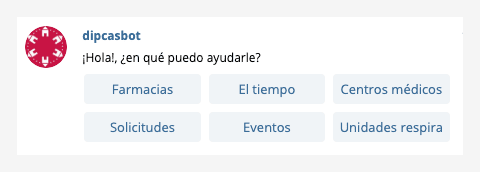Bots, machine learning and cognitive services are the main technological solutions offered by artificial intelligence (AI) to help companies and institutions continue to improve and innovate.
“Almost a third of Spanish companies consider AI as a key element in their innovation strategy but they have not yet started the implementation process.”.
The majority of large companies in Spain are applying AI-related solutions; 46% of these are doing so in the pilot phase, 11.5% have a defined roadmap, and the same percentage, according to a study by PWC, are already making a profit. The concern of companies regarding the experience they offer to users is clear, as 20.6% of them agree that improving customer satisfaction is the main reason they adopt this technology.
In the short term, one way to guarantee this satisfaction, assuming that the product or service is adequate and good, is through the use of bots or chatbots, so that the services are personalised based on the characteristics of the customers at the same time as product efficiency is increased and internal costs are better managed.
Where to start?
Without a doubt, we have to start with a roadmap framed by the company's strategy and by incorporating a customer-centred vision within the company's culture (we are going to use the term ‘customer’ in a broad sense, as it can refer to an internal area of the company, a shareholder or even a supplier).

The next question is whether we have the necessary talent to do this within the organisation or whether we have to resort to outsourcing the task. Beyond the technical implementation, the important thing is that the process involves the review of many key aspects, for which it is important to be well guided in the process. For example, the Castellón Provincial Council has created its first ‘bot official’, and for this it has sought the collaboration of Cuatroochenta.
In a generic way, there are many interrelated areas in the design and production of a bot; it is not mandatory to have all of them, but doing so will facilitate the success of the implementation and its subsequent improvement: Business Analysis, UX & CD, Programming, Tech Project Management, Business Model Development, Big Data & BI, Digital Marketing and Process Optimisation.
Once the decision has been made to incorporate AI into our customer service processes, as mentioned, the easiest way to start is by implementing bot technology. A chatbot is a technology capable of simulating a human conversation through a conversational interface (chat).
Before continuing, some good news: we can start with simple projects. Although the maximum power of this technology is obtained through the use of AI, bots that do not have real AI technology can be implemented, which is a good starting point for SMEs.

In a simple way, we have defined seven aspects that need to be taken into account if we want to implement a bot:
1. Study the feasibility of the proposal.
There are times when the proposal is unfeasible. Sometimes this is because it does not really add value to the client, other times it’s because we do not have the appropriate information system for its implementation, or the money to make an investment in this area. It should be taken in a strategic manner and made without careful considerations.
2. Analyse the necessary interactions.
Defining the interactions requires being very clear about the workflows in our organisation. A simple request for service renewal by a client requires knowing which client it is, what service it has contracted, the types of renewal associated with that product and that client. For example, if we are a bank and the legislation has changed, whether we must ask for an update of the customer’s ID if it is not up to date. These interactions can be linked to different areas, so it is an excellent opportunity to analyse and potentially rethink how we work.
3. Have clear objectives and do not create false expectations.
The main virtue of a chatbot is precisely that of talking with the recipient so that he or she finds a solution to their need. For this, we must be clear about what we want our chatbot to do. At the beginning, it is better to focus on a specific process than to try to cover too much, and to ensure that, in any case, whoever approaches the chatbot leaves satisfied with the experience.

4. Define the processes.

This involves the proper design of the conversational tree, which will be produced based on the final objective that we have defined for a specific process. In general, you must think about what the customer wants and make it easier for them to start from there and continue on their way with the fewest possible interactions.
Simple conversations, with concrete answers, specific actions (even with the integration of tools such as a calendar), and a chatbot with its own personality will aid the success of the process.
5. Analyse the costs.
A chatbot performs two main tasks: understanding, from a conservation, what a user requires, and responding appropriately and correctly. As we have said, it is not necessary to start with a chatbot with real AI technology implemented.
We can start with the use of predetermined answers (yes/no) so that our bot does not have higher learning needs (deep learning, cognitive services, machine learning, etc.); with these, the cost is lower. The more complex the conversational tree between the user and the organisation, the more difficult it will be to program the wizard and the type of tools involved, as we will see in the next point, and therefore the cost increases.
6. Determine the systems and tools involved.
Depending on what we have defined in the previous stages, our needs will range from simply integrating our chatbot into an existing messaging platform (Telegram, etc.), or using one of our own channels (for example, the website). We must determine where we are going to store the data we use in our interactions, whether that’s in our applications, which requires taking into account the link with our CRM and the connections with the APIs, or third-party platforms. In the most complex cases, CIOs will need to redesign their infrastructure to integrate AI, robots, and chatbots.
7. Convert interactions into conversational flows.
In successful conversational flows (since not all interactions are), in addition to the above, it is necessary to test how the user interacts with the chatbot and make changes. Thus, there is usually a period of monitoring and improving the solution and, if the decision adopted is strategic, a continuous improvement of the tool that will undoubtedly help support the relationship with the client but also the processes of the organisation.